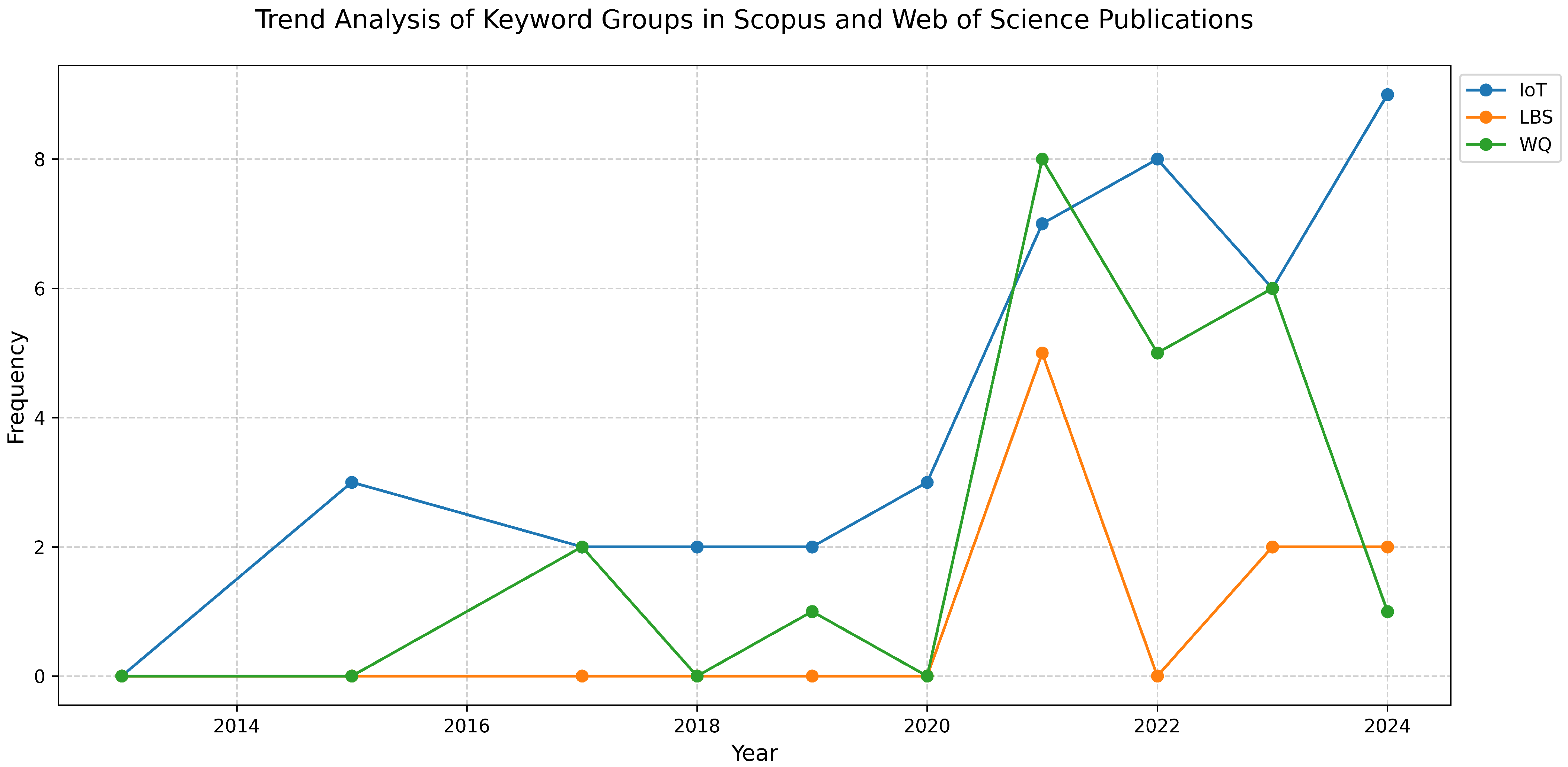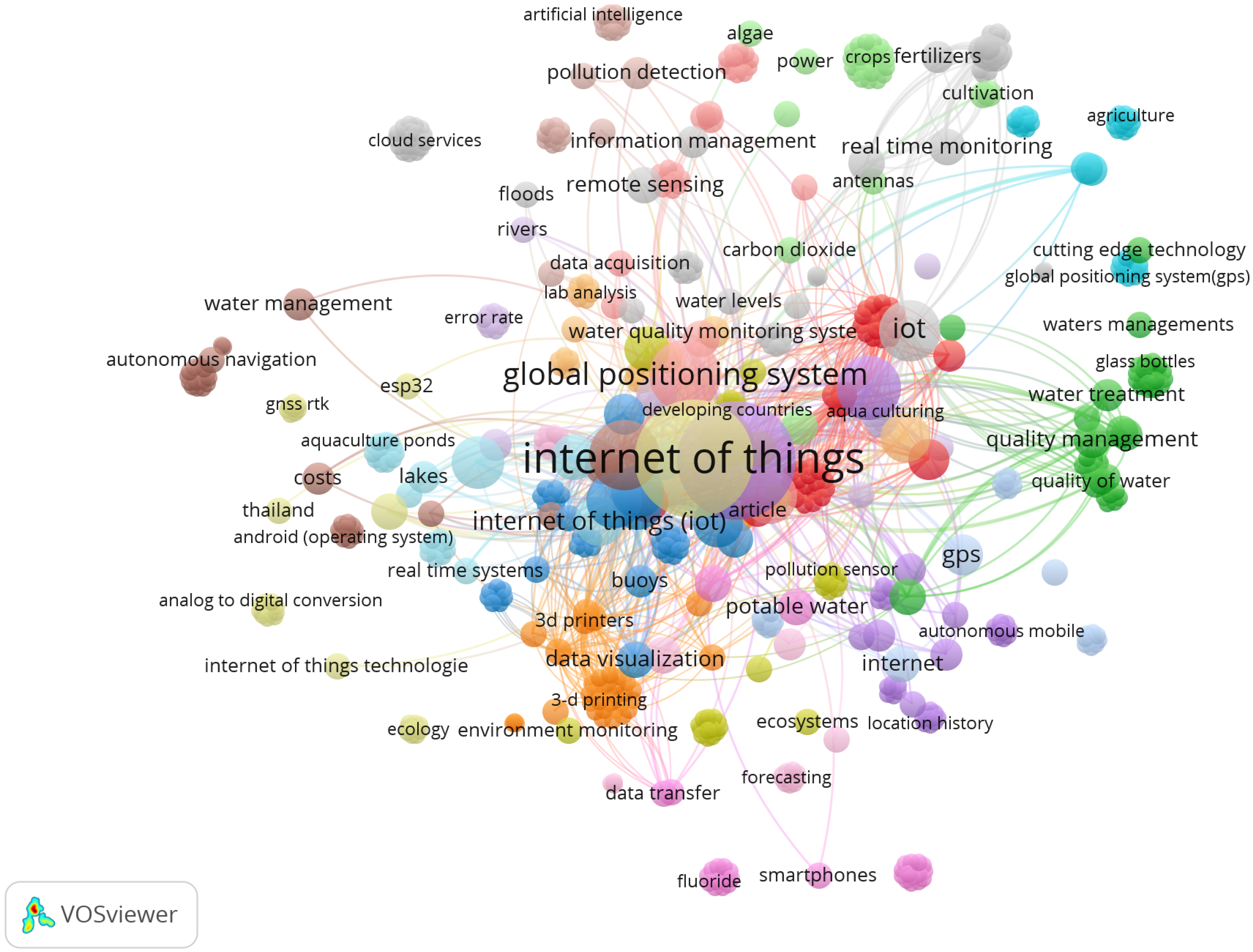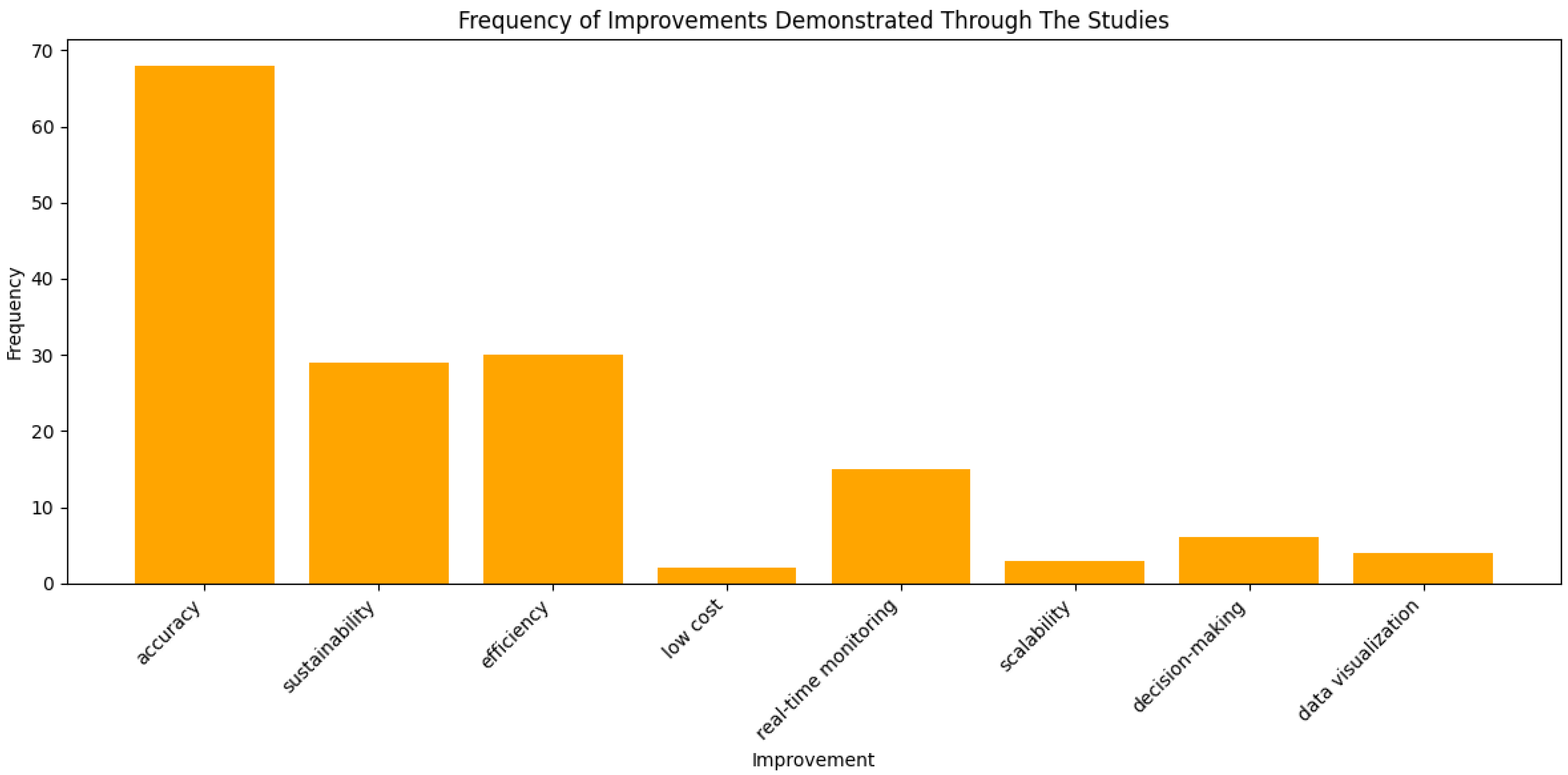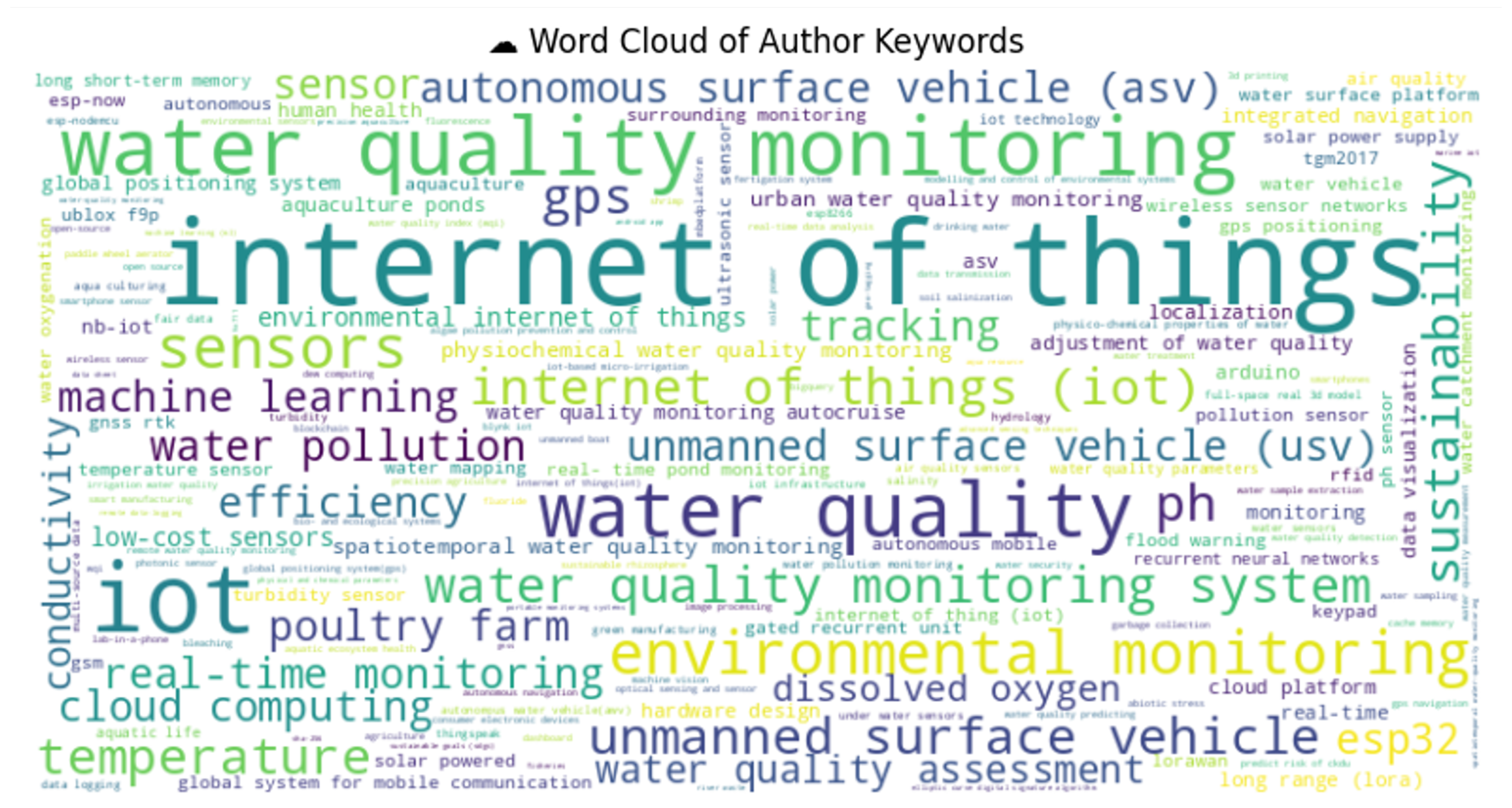The Integration of IoT (Internet of Things) Sensors and Location-Based Services for Water Quality Monitoring: A Systematic Literature Review
Abstract
:1. Introduction
2. The Methodology of the Literature Review
2.1. Review Methodology
2.2. Search Strategy (Eligibility Criteria Determination)
2.3. Screening and Eligibility
2.3.1. Inclusion Criteria
- The selected studies had to specifically address the integration of the IoT and LBSs in the context of WQ monitoring or water management.
- Only peer-reviewed journal articles were considered to maintain a high level of methodological accuracy, ensuring the high reliability and validity of the research papers selected for the review.
- The articles needed to be written in English.
- The studies needed to provide empirical data, detailed case studies, or comprehensive theoretical analyses that contributed directly to understanding the integration of the IoT and LBSs.
- Given the rapid evolution of IoT and LBS technologies, studies published within recent years were prioritized to ensure the review reflected current technological standards.
2.3.2. Exclusion Criteria
- Articles that were not written in English were excluded.
- Conference papers, theses, reviews, or any non-peer-reviewed publications were excluded to ensure robust quality control.
- Duplicate articles identified during the initial search were removed.
- Studies that discussed the IoT or LBSs in unrelated fields such as transportation, healthcare, or urban planning without direct application to WQ monitoring were excluded.
- Studies that discussed the IoT and LBSs separately, without addressing their integration for WQ monitoring, were not included.
2.4. Article Selection
2.4.1. Title and Abstract Screening
- In what type of environment was the system being implemented?
- What sensors were used and which parameters were measured to monitor WQ?
- What methods were employed to collect location information?
- What was the spatial and temporal resolution in the data collection and transfer method?
- How do these studies demonstrate improvements through IoT and LBS integration?
- How do the selected studies highlight the impact of IoT and LBS technologies on decision-making in water resource management?
2.4.2. Full-Text Screening
2.4.3. Data Extraction and Synthesis
3. Analyses of Major Findings
3.1. Data Synthesis
3.2. Answering the Questions
3.2.1. In What Type of Environment Was the System Being Implemented?
3.2.2. What Sensors Were Used and Which Parameters Were Measured to Monitor WQ?
3.2.3. What Methods Were Employed to Collect Location Information?
3.2.4. What Was the Spatial and Temporal Resolution in the Data Collection and Transfer Method?
3.2.5. How Do These Studies Demonstrate Improvements Through IoT and LBS Integration?
3.2.6. How Do the Selected Studies Highlight the Impact of IoT and LBS Technologies on Decision-Making in Water Resource Management?
4. Conclusions
Author Contributions
Funding
Conflicts of Interest
Abbreviations
| AI | Artificial Intelligence |
| BeiDou | Chinese GNSS |
| CEP | Circular Error Probability |
| DO | Dissolved oxygen |
| EC | Electric conductivity |
| Galileo | European GNSS |
| GLONASS | Russian GNSS |
| GNSS | Global Navigation Satellite System |
| GPS | US Navstar Global Positioning Service |
| I2C | Inter-Integrated Circuit |
| IoT | Internet of Things |
| LBS | Location-Based Service |
| ML | Machine learning |
| ORP | Oxidation–Reduction Potential |
| pH | Potential of Hydrogen |
| PICO | Participants, Intervention, Comparison, and Outcome |
| PRISMA | Preferred Reporting Items for Systematic Reviews and Meta-Analyses |
| QZSS | Japanese Quasi Zenith Satellite System (SBAS) |
| RTK | Real-Time Kinematic GNSS Positioning |
| SBAS | Satellite-Based Augmentation System |
| SLR | Systematic literature review |
| SPI | Serial Peripheral Interface |
| TDSs | Total Dissolved Solids |
| TTL | Transistor–Transistor Logic |
| UART | Universal Asynchronous Receiver/Transmitter |
| UAV | Unmanned Aerial Vehicle |
| USB | Universal Serial Bus |
| WQ | Water quality |
References
- Syeed, M.M.M.; Hossain, M.S.; Karim, M.R.; Uddin, M.F.; Hasan, M.; Khan, R.H. Surface water quality profiling using the water quality index, pollution index and statistical methods: A critical review. Environ. Sustain. Indic. 2023, 18, 100247. [Google Scholar] [CrossRef]
- Essamlali, I.; Nhaila, H.; Khaili, M.E. Advances in machine learning and IoT for water quality monitoring: A comprehensive review. Heliyon 2024, 10, e27920. [Google Scholar] [CrossRef]
- Agade, P.; Bean, E. GatorByte—An Internet of Things-based low-cost, compact, and real-time water resource monitoring buoy. HardwareX 2023, 14, e00427. [Google Scholar] [CrossRef]
- Yao, K.; Chen, Y.; Li, Y.; Zhang, X.; Zhu, B.; Gao, Z.; Lin, F.; Hu, Y. Water quality prediction of small-micro water body based on the intelligent-algorithm-optimized support vector machine regression method and unmanned aerial vehicles multispectral data. Sustainability 2024, 16, 559. [Google Scholar] [CrossRef]
- Koop, S.H.A.; Van Leeuwen, C.J. The challenges of water, waste and climate change in cities. Environ. Dev. Sustain. 2016, 19, 385–418. [Google Scholar] [CrossRef]
- Ferdowsi, A.; Piadeh, F.; Behzadian, K.; Mousavi, S.; Ehteram, M. Urban water infrastructure: A critical review on climate change impacts and adaptation strategies. Urban Clim. 2024, 58, 102132. [Google Scholar] [CrossRef]
- Alshami, A.; Ali, E.; Elsayed, M.; Eltoukhy, A.E.E.; Zayed, T. IoT Innovations in sustainable water and wastewater management and water quality monitoring: A comprehensive review of advancements, implications, and future directions. IEEE Access 2024, 12, 58427–58453. [Google Scholar] [CrossRef]
- Glasgow, H.B.; Burkholder, J.M.; Reed, R.E.; Lewitus, A.J.; Kleinman, J.E. Real-time remote monitoring of water quality: A review of current applications, and advancements in sensor, telemetry, and computing technologies. J. Exp. Mar. Biol. Ecol. 2004, 300, 409–448. [Google Scholar] [CrossRef]
- Trevathan, J.; Johnstone, R. Smart environmental monitoring and assessment technologies (SEMAT)—A new paradigm for low-cost, remote aquatic environmental monitoring. Sensors 2018, 18, 2248. [Google Scholar] [CrossRef]
- Wang, P. Research on intelligent monitoring of urban environment under the environment of the Internet of Things. E3S Web Conf. 2023, 406, 04024. [Google Scholar] [CrossRef]
- Carminati, M. Trends and paradigms in the development of miniaturized sensors for environmental monitoring. In Proceedings of the 2018 IEEE International Conference on Environmental Engineering, Milan, Italy, 12–14 March 2018. [Google Scholar] [CrossRef]
- Mulchandani, A.; Sadik, O.A. Chemical and biological sensors for environmental monitoring. ACS Symp. Ser. 2000, 762, 185–196. [Google Scholar] [CrossRef]
- Garcia Baigorri, A.; Parada, R.; Baeza, V.M.; Monzo, C. Leveraging urban water distribution systems with smart sensors for sustainable cities. Sensors 2024, 24, 7223. [Google Scholar] [CrossRef]
- Medrano, K.; Hernández, E.; Tejada, R.; Moreno, A. Tecnologías IoT para el monitoreo de la calidad del agua en la acuicultura. Eur. Public Soc. Innov. Rev. 2024, 10, 1–16. [Google Scholar] [CrossRef]
- Tang, J.; Lin, H.; Tian, Q. Design and realization of a water quality monitoring system based on the Internet of Things. Water Pract. Technol. 2024, 19, 3538–3554. [Google Scholar] [CrossRef]
- Vasile, V.; Nafornita, C.; Borda, M. Comparative study of satellite navigation systems. In Proceedings of the 2022 International Symposium on Electronics and Telecommunications (ISETC), Timisoara, Romania, 8–9 November 2018. [Google Scholar] [CrossRef]
- Yoshida, S.; Kirihara, T.; Tsuboi, S.; Toyono, T.; Kuwahara, T. Positional information service with high added value based on cooperation between GNSS and networks. NTT Tech. Rev. 2019, 17, 8–12. [Google Scholar] [CrossRef]
- Silva, P.F.E.; Kaseva, V.; Lohan, E.S. Wireless positioning in IoT: A look at current and future trends. Sensors 2018, 18, 2470. [Google Scholar] [CrossRef] [PubMed]
- Bartoletti, S.; Chiaraviglio, L.; Fortes, S.; Kennouche, T.E.; Solmaz, G.; Bernini, G.; Giustiniano, D.; Widmer, J.; Barco, R.; Siracusano, G.; et al. Location-based analytics in 5G and beyond. IEEE Commun. Mag. 2021, 59, 38–43. [Google Scholar] [CrossRef]
- Khajeh, S.A.; Saberikamarposhti, M.; Rahmani, A.M. Real-time scheduling in IoT applications: A systematic review. Sensors 2022, 23, 232. [Google Scholar] [CrossRef]
- Zulkifli, C.Z.; Garfan, S.; Talal, M.; Alamoodi, A.H.; Alamleh, A.; Ahmaro, I.Y.Y.; Sulaiman, S.; Ibrahim, A.B.; Zaidan, B.B.; Ismail, A.R.; et al. IoT-based water monitoring systems: A systematic review. Water 2022, 14, 3621. [Google Scholar] [CrossRef]
- De Camargo, E.T.; Spanhol, F.A.; Slongo, J.S.; Da Silva, M.V.R.; Pazinato, J.; De Lima Lobo, A.V.; Coutinho, F.R.; Pfrimer, F.W.D.; Lindino, C.A.; Oyamada, M.S.; et al. Low-cost water quality sensors for IoT: A systematic review. Sensors 2023, 23, 4424. [Google Scholar] [CrossRef]
- Jayaraman, P.; Nagarajan, K.K.; Partheeban, P.; Krishnamurthy, V. Critical review on water quality analysis using IoT and machine learning models. Int. J. Inf. Manag. Data Insights 2024, 4, 100210. [Google Scholar] [CrossRef]
- Pettorru, G.; Pilloni, V.; Martalò, M. Trustworthy localization in IoT networks: A survey of localization techniques, threats, and mitigation. Sensors 2024, 24, 2214. [Google Scholar] [CrossRef]
- Kossieris, S.; Tsiakos, V.; Tsimiklis, G.; Amditis, A. Inland water level monitoring from satellite observations: A scoping review of current advances and future opportunities. Remote Sens. 2024, 16, 1181. [Google Scholar] [CrossRef]
- Alkhayyal, M.; Mostafa, A. Recent developments in AI and ML for IoT: A systematic literature review on LORAWAN energy efficiency and performance optimization. Sensors 2024, 24, 4482. [Google Scholar] [CrossRef] [PubMed]
- Benicio, S.H.M.; Basso, R.E.; Formiga, K.T.M. Global applications of the CE-QUAL-W2 model in reservoir eutrophication: A systematic review and perspectives for Brazil. Water 2024, 16, 3556. [Google Scholar] [CrossRef]
- Sebestyen, H.; Popescu, D.E.; Zmaranda, R.D. A literature review on security in the Internet of Things: Identifying and analysing critical categories. Computers 2025, 14, 61. [Google Scholar] [CrossRef]
- López-Munoz, M.A.; Torrealba-Melendez, R.; Arriaga-Arriaga, C.A.; Tamariz-Flores, E.I.; López-López, M.; Quirino-Morales, F.; Munoz-Pacheco, J.M.; López-Marcos, F. Wireless dynamic sensor network for water quality monitoring based on the IoT. Technologies 2024, 12, 211. [Google Scholar] [CrossRef]
- Łukasik, S.; Szott, S.; Leszczuk, M. Multimodal image-based indoor localization with machine learning—A systematic review. Sensors 2024, 24, 6051. [Google Scholar] [CrossRef]
- Zamnuri, M.A.H.B.; Qiu, S.; Rizalmy, M.A.A.B.; He, W.; Yusoff, S.; Roeroe, K.A.; Du, J.; Loh, K. Integration of IoT in small-scale aquaponics to enhance efficiency and profitability: A systematic review. Animals 2024, 14, 2555. [Google Scholar] [CrossRef]
- Staniszewski, R.; Messyasz, B.; Dąbrowski, P.; Burdziakowski, P.; Spychała, M. Recent issues and challenges in the study of inland waters. Water 2024, 16, 1216. [Google Scholar] [CrossRef]
- Oberascher, M.; Rauch, W.; Sitzenfrei, R. Towards a smart water city: A comprehensive review of applications, data requirements, and communication technologies for integrated management. Sustain. Cities Soc. 2022, 76, 103442. [Google Scholar] [CrossRef]
- Agrawal, S.; Oza, P.; Kakkar, R.; Tanwar, S.; Jetani, V.; Undhad, J.; Singh, A. Analysis and recommendation system-based on PRISMA checklist to write systematic review. Assess. Writ. 2024, 61, 100866. [Google Scholar] [CrossRef]
- Mancin, S.; Sguanci, M.; Andreoli, D.; Soekeland, F.; Anastasi, G.; Piredda, M.; De Marinis, M.G. Systematic review of clinical practice guidelines and systematic reviews: A method for conducting comprehensive analysis. MethodsX 2023, 12, 102532. [Google Scholar] [CrossRef] [PubMed]
- Wang, J.; Lim, M.K.; Wang, C.; Tseng, M. The evolution of the Internet of Things (IoT) over the past 20 years. Comput. Ind. Eng. 2021, 155, 107174. [Google Scholar] [CrossRef]
- Balassa, B.E.; Nagy, N.G.; Gyurián, N. Perception and social acceptance of 5G technology for sustainability development. J. Clean. Prod. 2024, 467, 142964. [Google Scholar] [CrossRef]
- Sevak, K.Y.; George, B. The evolution of Internet of Things (IoT) research in business management: A systematic review of the literature. J. Internet Digit. Econ. 2024, 4, 242–265. [Google Scholar] [CrossRef]
- Rachakonda, L.P.; Siddula, M.; Sathya, V. A comprehensive study on IoT privacy and security challenges with focus on spectrum sharing in next-generation networks (5G/6G/beyond). High-Confid. Comput. 2024, 4, 100220. [Google Scholar] [CrossRef]
- Valencia-Arias, A.; Dávila, J.R.; Londoño-Celis, W.; Palacios-Moya, L.; Hernández, J.L.; Agudelo-Ceballos, E.; Uribe-Bedoya, H. Research Trends in the Use of the Internet of Things in Sustainability Practices: A Systematic review. Sustainability 2024, 16, 2663. [Google Scholar] [CrossRef]
- Aghaloo, K.; Sharifi, A.; Habibzadeh, N.; Ali, T.; Chiu, Y. How nature-based solutions can enhance urban resilience to flooding and climate change and provide other co-benefits: A systematic review and taxonomy. Urban For. Urban Green. 2024, 95, 128320. [Google Scholar] [CrossRef]
- Al Naqbi, H.; Zied, B.; Vian, A. Enhancing work productivity through generative artificial intelligence: A comprehensive literature review. Sustainability 2024, 16, 1166. [Google Scholar] [CrossRef]
- Jayakumar, D.; Bouhoula, A.; Al-Zubari, W.K. Unlocking the potential of artificial intelligence for sustainable water management focusing operational applications. Water 2024, 16, 3328. [Google Scholar] [CrossRef]
- Oliveira, V.H.; Díez, S.; Dolbeth, M.; Coelho, J.P. Restoration of degraded estuarine and marine ecosystems: A systematic review of rehabilitation methods in Europe. J. Hazard. Mater. 2024, 469, 133863. [Google Scholar] [CrossRef]
- Thong-Un, N.; Panthong, P.; Wongsaroj, W.; Takahashi, H.; Kikura, H. Development of an automatic paddle wheel aerator and re-mote movement water quality monitoring for use in a marine shrimp farm. Instrum. Mes. Métrol. 2024, 23, 79–92. [Google Scholar] [CrossRef]
- Kinar, N.J.; Brinkmann, M. Development of a sensor and measurement platform for water quality observations: Design, sensor integration, 3D printing, and open-source hardware. Environ. Monit. Assess. 2022, 194, 207. [Google Scholar] [CrossRef]
- Amuthakkannan, R.; Al Yaqoubi, M.H.A. Development of IoT-based water pollution identification to avoid destruction of aquatic life and to improve the quality of water. J. Eng. Trends Technol. 2023, 71, 355–370. [Google Scholar] [CrossRef]
- Zhang, C.; Zhan, Q.; Wang, Q.; Wu, H.; He, T.; An, Y. Autonomous dam surveillance robot system based on multi-sensor fusion. Sensors 2020, 20, 1097. [Google Scholar] [CrossRef]
- Abdolmaleki, H.; Jafari, A.; Mousazadeh, H.; Hajiahmad, A. Simulation, development and evaluation of an autonomous robotic boat used in aquacultures. J. Agric. Mach. 2021, 11, 161–171. [Google Scholar] [CrossRef]
- Blanco-Gómez, P.; Jiménez-García, J.L.; Cecilia, J.M. Low-cost automated GPS, electrical conductivity and temperature sensing device (EC + T Track) and Android platform for water quality monitoring campaigns. HardwareX 2022, 13, e00381. [Google Scholar] [CrossRef] [PubMed]
- Bresnahan, P.; Cyronak, T.; Brewin, R.J.; Andersson, A.; Wirth, T.; Martz, T.; Courtney, T.; Hui, N.; Kastner, R.; Stern, A.; et al. A high-tech, low-cost, Internet of Things surfboard fin for coastal citizen science, outreach, and education. Cont. Shelf Res. 2021, 242, 104748. [Google Scholar] [CrossRef]
- He, Y.; Yang, Y.; He, T.; Lai, Y.; He, Y.; Chen, B. Small and micro-water quality monitoring based on the integration of a full-space real 3D model and IoT. Sensors 2024, 24, 1033. [Google Scholar] [CrossRef] [PubMed]
- Odetti, A.; Bruzzone, G.; Ferretti, R.; Aracri, S.; Carotenuto, F.; Vagnoli, C.; Zaldei, A.; Scagnetto, I. Lake environmental data harvester (LED) for Alpine lake monitoring with autonomous surface vehicles (ASVs). Remote Sens. 2024, 16, 1998. [Google Scholar] [CrossRef]
- Staude, M.; Brożek, P.; Kostecka, E.; Tarnapowicz, D.; Wysocki, J. Remote water quality monitoring system for use in fairway applications. Appl. Sci. 2024, 14, 11406. [Google Scholar] [CrossRef]
- Qadir, M.I.; Mumtaz, R.; Manzoor, M.; Saleem, M.; Khan, M.A.; Charlesworth, S. Unmanned surface vehicle for intelligent water quality assessment to promote sustainable human health. Water Sci. Technol. Water Supply 2024, 24, 2259–2270. [Google Scholar] [CrossRef]
- Kimothi, S.; Thapliyal, A.; Singh, R.; Rashid, M.; Gehlot, A.; Akram, S.V.; Javed, A.R. Comprehensive database creation for potential fish zones using IoT and ML with assimilation of geospatial techniques. Sustainability 2023, 15, 1062. [Google Scholar] [CrossRef]
- Baghel, L.K.; Gautam, S.; Malav, V.K.; Kumar, S. TEMPSENSE: LORA enabled integrated sensing and localization solution for water quality monitoring. IEEE Trans. Instrum. Meas. 2022, 71, 3000311. [Google Scholar] [CrossRef]











| Device Name | Supported by GNSS Constellation | Accuracy [CEP 1] | Power Consumption | Communication Interface |
|---|---|---|---|---|
| u-blox Neo-6M | GPS | ∼2.5 m | ∼37 mA @ 3.3V | UART 2, SPI 3, I2C 4 |
| u-blox M8N | GPS, Galileo, GLONASS, BeiDou | ∼2.5 m | ∼29 mA @ 3.3 V | UART, SPI, I2C |
| BN-180 GPS | GPS, Galileo, GLONASS, BeiDou, QZSS, SBAS 5 | ∼1–3 m | ∼30 mA @ 3.3 V | UART (TTL 6) |
| u-blox CAM-M8Q | GPS, Galileo, GLONASS, BeiDou | ∼2.5 m | ∼27 mA @ 3.3 V | UART |
| LQBD1202 | GPS, BeiDou | ∼1 m | ∼40 mA @ 3.3 V | UART |
| SparkFun GPS-RTK2 (ZED-F9P) | GPS, Galileo, GLONASS, BeiDou | ∼1 cm (RTK 7)/∼1.5 m (standard) | ∼68 mA @ 3.3 V | UART, USB 8, I2C, SPI |
| SIM808 | GPSu | ∼2.5 m | ∼1 mA (sleep)/∼300 mA (active) @ 3.4–4.4 V | UART |
| SparkFun NEO-M8U | GPS, Galileo, GLONASS, BeiDou | ∼2.5 m (with sensor fusion) | ∼35 mA @ 3.3 V | UART, I2C, SPI |
Disclaimer/Publisher’s Note: The statements, opinions and data contained in all publications are solely those of the individual author(s) and contributor(s) and not of MDPI and/or the editor(s). MDPI and/or the editor(s) disclaim responsibility for any injury to people or property resulting from any ideas, methods, instructions or products referred to in the content. |
© 2025 by the authors. Licensee MDPI, Basel, Switzerland. This article is an open access article distributed under the terms and conditions of the Creative Commons Attribution (CC BY) license (https://creativecommons.org/licenses/by/4.0/).
Share and Cite
Bandara, R.M.P.N.S.; Jayasignhe, A.B.; Retscher, G. The Integration of IoT (Internet of Things) Sensors and Location-Based Services for Water Quality Monitoring: A Systematic Literature Review. Sensors 2025, 25, 1918. https://doi.org/10.3390/s25061918
Bandara RMPNS, Jayasignhe AB, Retscher G. The Integration of IoT (Internet of Things) Sensors and Location-Based Services for Water Quality Monitoring: A Systematic Literature Review. Sensors. 2025; 25(6):1918. https://doi.org/10.3390/s25061918
Chicago/Turabian StyleBandara, Rajapaksha Mudiyanselage Prasad Niroshan Sanjaya, Amila Buddhika Jayasignhe, and Günther Retscher. 2025. "The Integration of IoT (Internet of Things) Sensors and Location-Based Services for Water Quality Monitoring: A Systematic Literature Review" Sensors 25, no. 6: 1918. https://doi.org/10.3390/s25061918
APA StyleBandara, R. M. P. N. S., Jayasignhe, A. B., & Retscher, G. (2025). The Integration of IoT (Internet of Things) Sensors and Location-Based Services for Water Quality Monitoring: A Systematic Literature Review. Sensors, 25(6), 1918. https://doi.org/10.3390/s25061918







